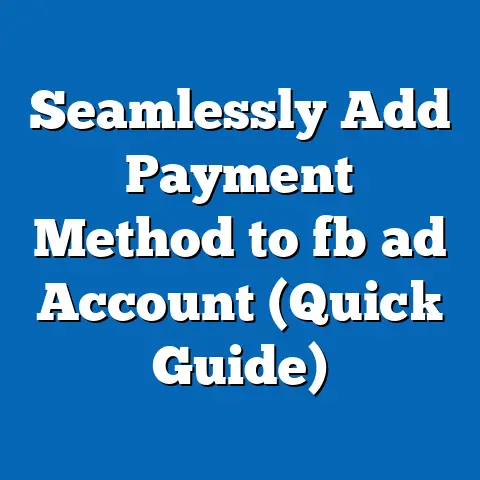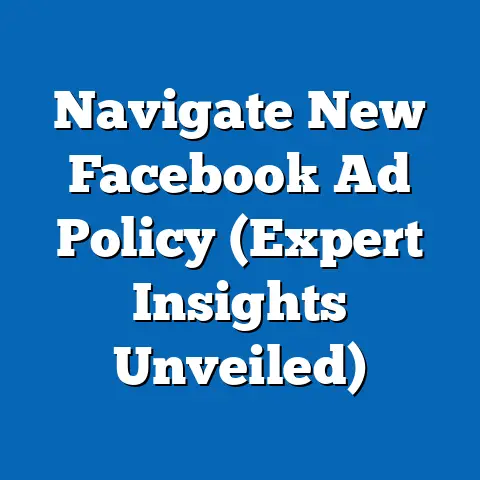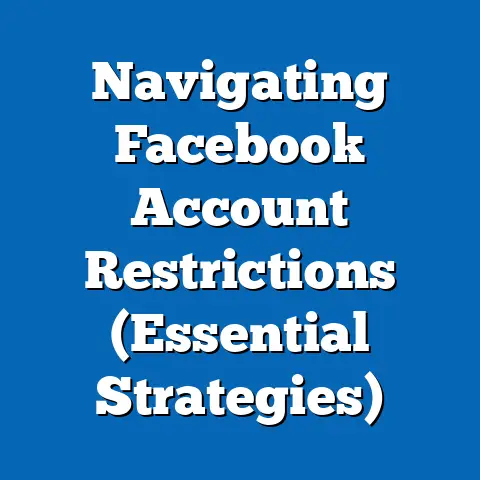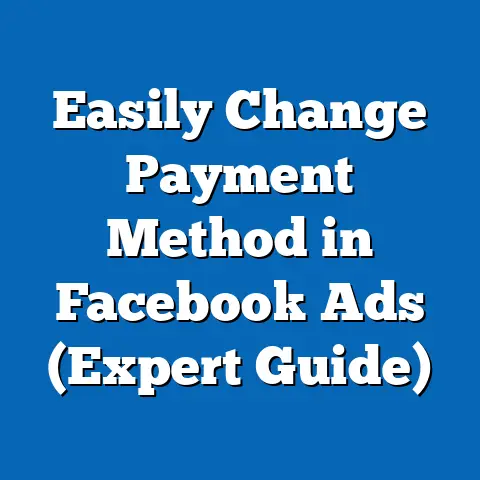Why Is Facebook Showing Ads? (Insights Unveiled)
Have you ever scrolled through your Facebook feed and felt bombarded by ads? It’s a common experience. You might find yourself wondering, “Why are there so many ads?” or “How does Facebook know what I’m interested in?” Are they truly tailored to my individual interests, or is it just a random barrage of products and services? As a digital marketing specialist with years of experience navigating the ever-changing landscape of Facebook advertising, I’ve heard these questions countless times.
This article aims to demystify the world of Facebook ads. We’ll dive deep into the reasons behind Facebook’s advertising strategy, explore its implications for users, and examine what it all means for businesses trying to reach their target audiences. Get ready to understand the intricate workings of Facebook advertising, from its humble beginnings to its current dominance in the digital marketing world.
The Evolution of Facebook Ads
To understand why Facebook is brimming with ads today, it’s crucial to look back at its origins and trace the evolution of its advertising model.
The first foray into advertising was relatively simple, consisting of banner ads and sponsored groups. These were far less sophisticated than the targeted ads we see today. One of the key milestones in Facebook’s advertising evolution was the introduction of News Feed Ads in 2006. This marked a significant shift as ads began to integrate directly into the user experience, appearing alongside content from friends and family.
I remember when these News Feed Ads first appeared. Many users, myself included, found them disruptive at first. However, Facebook was careful to present them in a way that felt somewhat organic, mimicking the look and feel of regular posts. This was a subtle but crucial step in normalizing advertising on the platform.
Another pivotal moment came with the development of more sophisticated targeting capabilities. Facebook began collecting vast amounts of data about its users – demographics, interests, behaviors, and connections. This data became the foundation for targeted advertising, allowing businesses to reach specific audiences with unprecedented precision.
Growth of the Ad Revenue Model
As Facebook’s user base exploded, so did its potential as an advertising platform. The business model transitioned from simply providing a social networking service to monetizing its user base through ads. Facebook realized that by leveraging the wealth of data it possessed, it could offer advertisers unparalleled reach and targeting capabilities.
The numbers speak for themselves. In 2009, Facebook’s advertising revenue was around $700 million. By 2022, it had ballooned to over $116 billion! This exponential growth underscores how central advertising has become to Facebook’s business model.
This growth is not just about the sheer volume of ads; it’s also about the increasing sophistication of ad formats and targeting techniques. Facebook has continuously invested in improving its advertising platform, introducing new ad formats like video ads, carousel ads, and lead generation ads. These innovations have made advertising on Facebook more engaging and effective, attracting more businesses and driving up ad revenue.
Key Takeaway: Facebook’s journey from a social networking site to an advertising powerhouse is a testament to its ability to adapt and innovate. The introduction of News Feed Ads and the development of sophisticated targeting capabilities were crucial turning points in this evolution.
How Facebook Determines Which Ads to Show
The magic (or perhaps the mystery, depending on your perspective) of Facebook ads lies in how the platform determines which ads to show to which users. This involves a complex interplay of user data, ad targeting mechanisms, and the algorithms that power the entire system.
User Data Collection
At the heart of Facebook’s advertising strategy is its ability to collect and analyze vast amounts of data about its users. This data forms the basis for creating detailed user profiles, which advertisers can then use to target specific audiences.
So, what kind of data does Facebook collect?
- Demographics: This includes basic information like age, gender, location, education, and relationship status.
- Interests: Facebook tracks the pages you like, the groups you join, and the topics you engage with. This provides insights into your interests and hobbies.
- Behaviors: This encompasses your online activity, such as the websites you visit, the apps you use, and the purchases you make. Facebook uses cookies and tracking pixels to monitor your behavior across the web.
- Connections: Facebook analyzes your network of friends, family, and colleagues to understand your social connections and influence.
I’ve seen firsthand how detailed these user profiles can be. In one campaign I ran for a local bookstore, we were able to target users who had expressed an interest in specific authors, genres, and even literary events. The level of granularity was astonishing, and it allowed us to reach a highly engaged audience.
Cookies and tracking pixels play a crucial role in this data collection process. Cookies are small text files that websites store on your computer to remember your preferences and track your activity. Tracking pixels are tiny images embedded in websites and emails that allow Facebook to monitor your behavior even when you’re not on the platform.
All of this data is fed into Facebook’s algorithms, which use machine learning to identify patterns and predict your future behavior. This allows Facebook to show you ads that are more likely to be relevant and engaging.
Ad Targeting Mechanisms
With all this user data in hand, Facebook offers advertisers a wide range of targeting options to reach their desired audiences. Here are some of the most common targeting mechanisms:
- Geographic Targeting: This allows you to target users based on their location, from entire countries to specific cities or even neighborhoods.
- Interest-Based Targeting: This lets you target users based on their interests, as determined by their Facebook activity.
- Demographic Targeting: This enables you to target users based on their demographic characteristics, such as age, gender, and education.
- Behavioral Targeting: This allows you to target users based on their online behavior, such as the websites they visit and the purchases they make.
- Lookalike Audiences: This powerful feature allows you to create audiences that are similar to your existing customers. Facebook analyzes the characteristics of your customers and identifies other users who share those traits.
- Custom Audiences: This lets you upload your own customer data, such as email addresses or phone numbers, and target those users on Facebook.
The algorithms that determine ad placements are incredibly complex. Facebook takes into account a variety of factors, including the relevance of the ad to the user, the quality of the ad creative, and the bidding strategy of the advertiser. The goal is to show users ads that are both relevant and engaging, while also maximizing revenue for Facebook.
The Role of Advertisers
Businesses play a crucial role in the Facebook advertising ecosystem. They are the ones who create the ads, choose their target audiences, and set their budgets. To be successful on Facebook, advertisers need to understand the platform’s targeting capabilities and create compelling ad creatives that resonate with their target audiences.
For example, a clothing retailer might create a Facebook ad campaign targeting women aged 25-45 who are interested in fashion and online shopping. They could use geographic targeting to reach users in specific cities or regions. The ad creative might feature images of their latest clothing line, along with a compelling call to action, such as “Shop Now” or “Explore Our New Collection.”
I’ve seen many businesses achieve remarkable results with Facebook ads. One of my clients, a local bakery, used Facebook ads to promote their new line of gluten-free products. They targeted users who had expressed an interest in gluten-free diets and healthy eating. The campaign was incredibly successful, driving a significant increase in sales and brand awareness.
Key Takeaway: Facebook’s advertising strategy is built on a foundation of user data collection, sophisticated targeting mechanisms, and the active participation of businesses. The platform’s algorithms work tirelessly to match the right ads with the right users, creating a personalized advertising experience.
The Benefits of Facebook Ads
While some users may find the abundance of ads on Facebook annoying, there are undeniable benefits to this advertising model, both for users and advertisers.
For Users
Believe it or not, targeted ads can actually enhance the user experience. By presenting relevant products and services, Facebook ads can help users discover new brands and promotions that align with their interests.
Think about it: Have you ever stumbled upon a product or service on Facebook that you ended up loving? I know I have! Targeted ads can be a valuable tool for discovering new things that you might not have found otherwise.
For example, if you’re a frequent traveler, you might appreciate seeing ads for travel deals, hotel discounts, or new travel gadgets. If you’re a fitness enthusiast, you might be interested in ads for workout gear, healthy recipes, or fitness apps.
I’ve also seen Facebook ads used to promote local events, such as concerts, festivals, and community gatherings. This can be a great way to stay informed about what’s happening in your area and discover new experiences.
For Advertisers
The advantages of advertising on Facebook are numerous, making it a popular choice for businesses of all sizes.
- Cost-Effectiveness: Compared to traditional advertising channels like television or print, Facebook ads can be incredibly cost-effective. You can set your own budget and target specific audiences, ensuring that you’re not wasting money on reaching people who are unlikely to be interested in your products or services.
- Extensive Reach: With billions of users worldwide, Facebook offers an unparalleled reach for advertisers. You can target users in virtually any country or region, making it an ideal platform for businesses looking to expand their reach.
- Detailed Analytics: Facebook provides advertisers with detailed analytics on their ad campaigns. You can track metrics like impressions, clicks, conversions, and return on ad spend (ROAS). This data allows you to optimize your campaigns and improve your results over time.
I’ve seen businesses achieve incredible growth by leveraging Facebook ads. One of my clients, a small e-commerce store, used Facebook ads to increase their sales by 300% in just a few months. They were able to target a highly specific audience and create compelling ad creatives that drove conversions.
Key Takeaway: Facebook ads offer benefits for both users and advertisers. Targeted ads can enhance the user experience by presenting relevant products and services, while advertisers can leverage Facebook’s cost-effectiveness, extensive reach, and detailed analytics to achieve their business goals.
Controversies and Criticisms Surrounding Facebook Ads
Despite the benefits, Facebook ads have also faced their fair share of controversies and criticisms, particularly regarding privacy concerns and ad saturation.
Privacy Concerns
The ongoing debates around user privacy and data security are a major concern for many Facebook users. The platform’s extensive data collection practices have raised questions about how user data is being used and whether it is being adequately protected.
One of the biggest concerns is the potential for data breaches. If Facebook’s data is compromised, it could expose sensitive information about millions of users, leading to identity theft and other security risks.
Another concern is the lack of transparency around how Facebook uses user data. Many users are unaware of the extent to which their data is being collected and analyzed. This lack of transparency can erode trust and make users feel like they are being exploited.
The Cambridge Analytica scandal, which came to light in 2018, had a profound impact on user trust. The scandal revealed that Cambridge Analytica, a political consulting firm, had harvested data from millions of Facebook users without their consent. This data was then used to target users with political ads, potentially influencing their voting decisions.
The scandal sparked widespread outrage and led to increased scrutiny of Facebook’s data practices. It also prompted calls for stricter regulations to protect user privacy.
Ad Saturation and User Experience
Another common criticism of Facebook ads is that there are simply too many of them. Users often complain that their feeds are cluttered with ads, making it difficult to find the content they actually want to see.
The balance between user experience and ad saturation is a delicate one. While Facebook needs to generate revenue through ads, it also needs to ensure that users are not overwhelmed or annoyed by the constant presence of ads.
Excessive or irrelevant ads can lead to user frustration and decreased engagement. Users may be more likely to unfollow pages, block ads, or even leave the platform altogether.
Facebook has taken steps to address this issue, such as limiting the number of ads that can appear in a user’s feed. However, the problem of ad saturation remains a challenge.
Key Takeaway: Facebook ads have faced significant controversies and criticisms, particularly regarding privacy concerns and ad saturation. The platform needs to address these issues to maintain user trust and ensure a positive user experience.
The Future of Facebook Advertising
The world of digital advertising is constantly evolving, and Facebook is adapting to stay ahead of the curve. Emerging trends and potential regulatory changes are likely to shape the future of advertising on the platform.
Emerging Trends
Several emerging trends are poised to transform the landscape of Facebook advertising:
- Augmented Reality (AR) Ads: AR ads allow users to interact with products in a virtual environment. For example, a furniture retailer could allow users to see how a piece of furniture would look in their home using AR.
- Video Content: Video has become increasingly popular on Facebook, and video ads are now a key part of the platform’s advertising strategy. Video ads are more engaging and can convey more information than static images.
- Influencer Partnerships: Influencer marketing is a growing trend, and Facebook is making it easier for businesses to partner with influencers to promote their products or services.
I believe that these emerging trends will make Facebook ads more engaging, interactive, and personalized. They will also provide advertisers with new ways to reach their target audiences and drive conversions.
Facebook is also adapting to changes in consumer behavior and technological advancements. For example, the platform is investing heavily in artificial intelligence (AI) to improve its ad targeting capabilities and personalize the user experience.
Regulatory Landscape
Potential future regulations could have a significant impact on Facebook’s advertising model. Data protection laws, such as the General Data Protection Regulation (GDPR) in Europe, are already forcing Facebook to be more transparent about its data practices and give users more control over their data.
Stricter advertising standards could also limit the types of ads that can be shown on Facebook. For example, regulations could restrict ads for certain products, such as alcohol or tobacco, or require advertisers to disclose more information about their products or services.
These changes might shape the future of advertising on the platform by forcing Facebook to adopt more privacy-friendly and transparent advertising practices. It may also lead to a more level playing field for advertisers, as smaller businesses may find it easier to compete with larger companies.
Key Takeaway: The future of Facebook advertising is likely to be shaped by emerging trends and potential regulatory changes. Advertisers will need to adapt to these changes to remain successful on the platform.
Conclusion
In conclusion, the presence of ads on Facebook is a complex issue with multiple layers. It is a reflection of Facebook’s evolution from a social networking site to an advertising-driven business. The platform’s ability to collect and analyze user data has enabled it to offer advertisers unparalleled targeting capabilities, but it has also raised concerns about privacy and ad saturation.
Facebook ads are a dual-edged sword. On one hand, they can enhance the user experience by presenting relevant products and services. On the other hand, they can be annoying and intrusive if they are excessive or irrelevant.
The future of Facebook advertising is likely to be shaped by emerging trends and potential regulatory changes. Advertisers will need to adapt to these changes to remain successful on the platform.
As we move forward in the digital age, the evolution of advertising will continue, and Facebook will undoubtedly play a significant role in shaping its trajectory. The challenge will be to strike a balance between the needs of businesses and the rights of users, ensuring that advertising remains a valuable and engaging part of the online experience.





